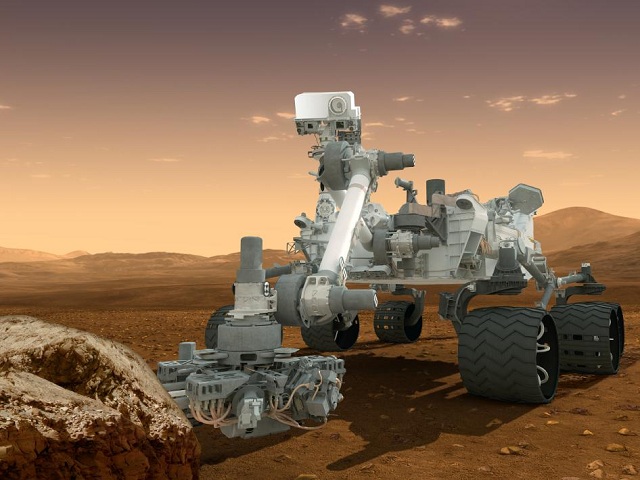What Can We Learn About Global Warming From The Mars Rover?
Life On Mars?
Climate Models and the Carbon Cycle
Does Mars Disprove Global Warming?
The latest Mars rover, Curiosity, landed on the surface of the Red Planet on 6th
of August 2012 and is currently sampling, analyzing and photographing
the surface of the planet. The Mars rover has several primary goals
whilst on the planet, with the overall aim of determining whether Mars
could ever have supported life. To do this, the Curiosity rover
will climb up the inside of the 5km high Gale Crater, sampling rocks as
it goes. In order to determine whether the planet was once habitable,
the past conditions of the Martian climate must be unraveled. But how
much can we learn about our own climatic fate from our neighbor? This
article aims to outline how much information can be gained about climate
change from Mars and the dangers of predicting too much from another
planet.

An artist’s impression of how the Mars rover Curiosity looks on the surface of the red planet. Image Source: NASA
The great benefit of the Mars rover is that it will allow climate
change theory to be tested in a real world situation. However detailed
climate change models have become, it is still impossible to test the
various hypotheses on the Earth’s climate without inherent dangers.
Scientists do not want to muck about with the only atmosphere we have
just to prove a point!There is much proof that Mars was once, if not a green planet, a planet that once held flowing water and possibly life. The previous Mars rover, Opportunity, discovered almost irrefutable proof of liquid water on the planet’s surface when it discovered a thin vein of gypsum, which must have precipitated from water. Other evidence includes satellite photos of ancient deltas, rilles and rivers. However, over billions of years the surface of the planet was all but stripped of its water content, due to constant battering from solar winds. The current Mars rover will look at how exactly Mars did lose all its water, and how this could relate to the Earth.
Climate scientists are extremely excited about the Curiosity mission, as by discovering more about the climate on Mars, models of Earth’s climate can be refined. Often, looking at the climate of another planet will help to consolidate existing theories by reducing margins of error in models. It may also throw up questions that have not been fully considered before. When looking at Venus for example, scientists greatly refined models regarding wind, as the models they applied to the planet did not correlate correctly.
It is hoped that similar refinements to models will be made when searching the surface of Mars, specifically models relating to the carbon cycle. The carbon cycle is the method by which carbon is exchanged between the different ‘spheres’ of the planet i.e. the hydrosphere, biosphere, geosphere, and the atmosphere. The carbon cycle has a profound effect on the Earth’s climate, as the temperature and climate of the planet can be altered heavily depending on the amount of CO2 in the atmosphere, or the amount trapped in the oceans. Since the industrial revolution, people have directly affected the Earth’s carbon cycle by adding carbon straight into the atmosphere which, according to the majority of climate scientists, is altering the temperature of the planet. By looking at the carbon cycle on Mars, it is hoped that some important questions, such as ‘where does carbon go?’ and ‘Does it ever come back again via volcanoes?’ can be answered, even though the atmosphere of Mars is very different.
However, basing climate change theory on activity seen on other bodies in the solar system can be misleading. There have been several theories that discuss how the climate changes on other planets shows that recent global warming is more likely to be caused by external events rather than anthropogenic activity. In 2007 a Russian planetary scientist, Habibullo Abdussamatov, proposed that the increasing temperatures and melting ice on earth was being mirrored by Mars, and therefore the cause of this was more likely to be an increase in solar irradiance. There has also been a perceived increase in temperature on the dwarf plant Pluto in recent years, but the suggestion that these changes are related to temperature changes on Earth is refuted by most climate scientists.
Firstly, the Sun’s energy output has been consistently measured since 1978, and there has been no measured change in this output. Even if there was a change in the Sun’s output, this would mean that all the moons and planets in the solar system would be experiencing similar temperature changes, not just three.
Furthermore, it is very difficult to gain high quality temperature data from Mars and Pluto over a long period of time. It has been suggested that the perceived shrinking of the Martian icecap may be due to a regional effect, increased winds (leading to a darkened surface and hence a higher albedo) or just large natural fluctuations. The cause of Pluto’s warming is less clear, but it may be due to a release of methane gas from ice as Pluto moves closer to the Sun.

No comments:
Post a Comment